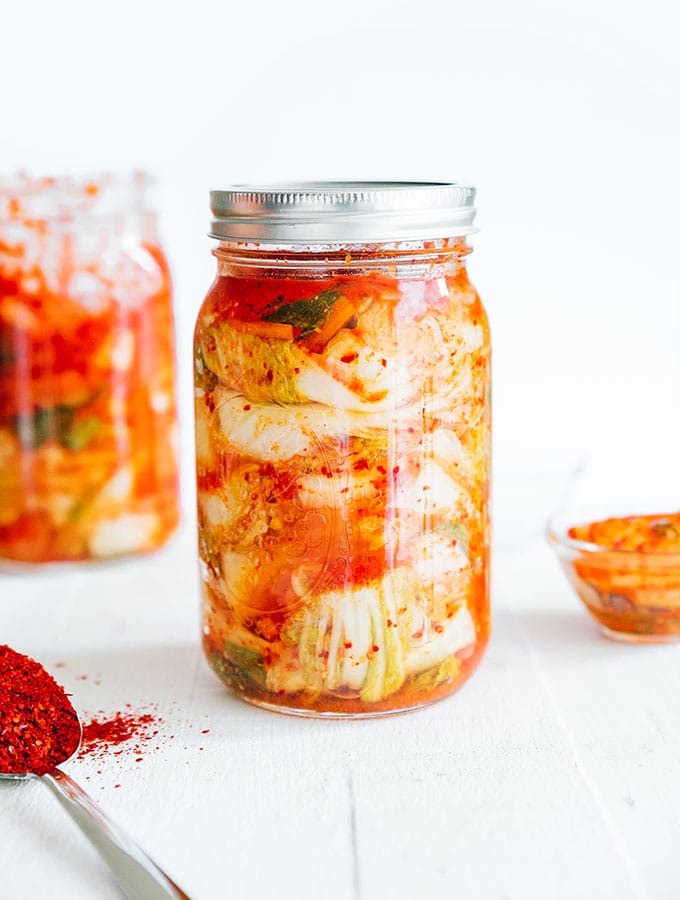Basic Starter Kimchi
|
Lacto-fermented condiments are easy to make. Vegetables are first washed, cut up, mixed with salt and herbs/spices then pounded briefly to release the juices. They are then pressed into an air tight container. Salt inhibits putrefying bacteria for several days until enough lactic acid is produced to preserve the vegetables for several months. The amount of salt can be reduced or even eliminated if whey is added to the pickling solution.
During the first few days of fermentation, the vegetables are kept at room temperature; afterwards they must be placed in a cool dark place for long term preservation. It is important to use the best quality organic vegetables, sea salt and filtered or pure water for lacto-fermentation. Lactobacilli needs plenty of nutrients to do their work, and if the vegetables are deficient, the process of fermentation will not proceed well. To ensure good food hygiene, it is important to sterilise your jars and utensils before use. 1 head of chinese cabbage (Wong bok), cored and shredded 1 bunch of green onions/scallions chopped 1 cup carrot, grated 1/2 daikon radish, grated 1 tablespoon freshly grated ginger 3 gloves of garlic, peeled and minced 1/2 teaspoon dried chili flakes 1 tablespoon sea salt 4 tablespoons whey (if not available, use an additional 1 tablespoon of salt). |
Place vegetables, ginger, garlic, chili flakes, sea salt and whey into a bowl and pound with a wooden pounder or meat hammer to release juices. Place vegetable and juices in a 1 litre wide mouthed mason jar. Press down firmly with a pounder until the juices come to the top and cover the vegetables. The top of the vegetables should be at least 3cm below the top of the jar, to allow for expansion. Close the lids on the jars tightly and keep at room temperature for about 3 days (@ 22 degrees celsius), If your kitchen is colder, more time will be needed. Less if it is very warm.
After 2-4 days at room temperature, the jars should be placed in a dark cool spot ideally at around 5 degrees. In time past, crocks of lacto-fermented vegetables were kept in root cellars or caves. A wine cellar would be perfect, or failing that, the top shelf of your refrigerator will do. Kimchi can be eaten immediately (mild), or left for a couple of weeks to increase in flavour.
Lacto-fermented vegetables are not meant to be eaten in large quantites, rather used as a condiment to be added on the side of your plate.
That is how simple it is to make fermented vegetables. Once you have a taste for them, you can experiment with traditional recipes adding fish sauce and salted shrimp. Yum.
How do you know if your Kimchi has gone bad?
Kimchi is naturally sour and pungent. As long as you don’t see mould or notice any foul odors, your kimchi should be safe to eat. Mould typically prefers warmer temperatures but can grow in refrigerated food as it ages, especially if it has been improperly stored. It forms a fuzzy mass or small dots and ranges in color from white, black, blue or green. Using clean utensils with your kimchi will prevent contamination.
After 2-4 days at room temperature, the jars should be placed in a dark cool spot ideally at around 5 degrees. In time past, crocks of lacto-fermented vegetables were kept in root cellars or caves. A wine cellar would be perfect, or failing that, the top shelf of your refrigerator will do. Kimchi can be eaten immediately (mild), or left for a couple of weeks to increase in flavour.
Lacto-fermented vegetables are not meant to be eaten in large quantites, rather used as a condiment to be added on the side of your plate.
That is how simple it is to make fermented vegetables. Once you have a taste for them, you can experiment with traditional recipes adding fish sauce and salted shrimp. Yum.
How do you know if your Kimchi has gone bad?
Kimchi is naturally sour and pungent. As long as you don’t see mould or notice any foul odors, your kimchi should be safe to eat. Mould typically prefers warmer temperatures but can grow in refrigerated food as it ages, especially if it has been improperly stored. It forms a fuzzy mass or small dots and ranges in color from white, black, blue or green. Using clean utensils with your kimchi will prevent contamination.

